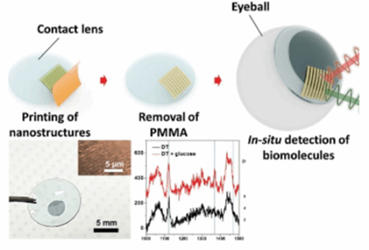"Smart" Contact Lens Uses Optical Biosensing To Detect Glucose

Scientists at the University of Houston (UH) have developed a new approach to glucose-sensing contact lenses by integrating an optical sensor. Though the correlation between glucose levels in tear samples and traditional blood samples is not yet established, the researchers said that their “smart” contact lens prototype demonstrates the versatility of their biosensing technology and a possible non-invasive alternative to existing glucose monitors.
Raman scattering spectroscopy (RSS) is a technique that analyzes how photons of light scatter when bounced off a material to identify its molecular makeup. Wei-Chuan Shih, associate professor of electrical and computer engineering at UH and director of the NanoBioPhotonics Group Lab, commented in a press release that glucose is a “good target” for this type of optical sensing. Shih’s research at UH, soon to be published by Advanced Materials, on previous technology developed by Shih while he was working at MIT.
Shih’s contact lens — which is a collaboration between UH scientists and engineers at the Korea Institute of Science and Technology — was built using a network of gold nanowires stacked on gold film using solvent-assisted nanotransfer printing. The gold optimizes the RSS so that the sensors can detect molecules from small samples by creating “hot spots” that intensify the RSS signal, said researchers. According to Shih, this new approach could be the key to developing a non-invasive glucose monitor, something Shih calls “a needle in a haystack challenge.”
For the past two years, Verily and Novartis have been working together to develop a “smart contact lens,” including a model with an integrated glucose sensor. Novartis CEO Joe Jiminez told a Swiss newspaper last year the project was “progressing well” and that he hoped to begin human clinical trials in 2016, though he noted that their prototype was indicated only for advanced vision correction.
In a recent review of Verily’s developing technology by STAT, a former Verily manager said that a glucose-sensing contact lens remains just a theoretical idea at Verily, and that attempts at a workable prototype had failed. In a separate interview, a former chief scientific officer at LifeScan Division of J&J explained that there have been no definitive studies that indicate monitoring glucose levels in tears is comparable to traditional methods of testing blood samples, because too many environmental factors can influence results.
Shih acknowledged the difficulties in establishing a comparison blood and tear samples, but the UH research presents many application possibilities, and Shih commented that glucose monitoring is a “grand challenge to be solved.”
“Everyone knows that tears have a lot to mine,” said Shih in the press release. “The question is whether you have a detector that is capable of mining it, and how significant it is for real diagnostics.”
Medella — a startup funded by the Thiel Foundation — entered the race towards a glucose-sensing contact lens in 2013 and recently raised $1.4 million in seed money from capital investors to continue product development. Medella’s lens lasts up to a month, and researchers say the system is easy to calibrate.
